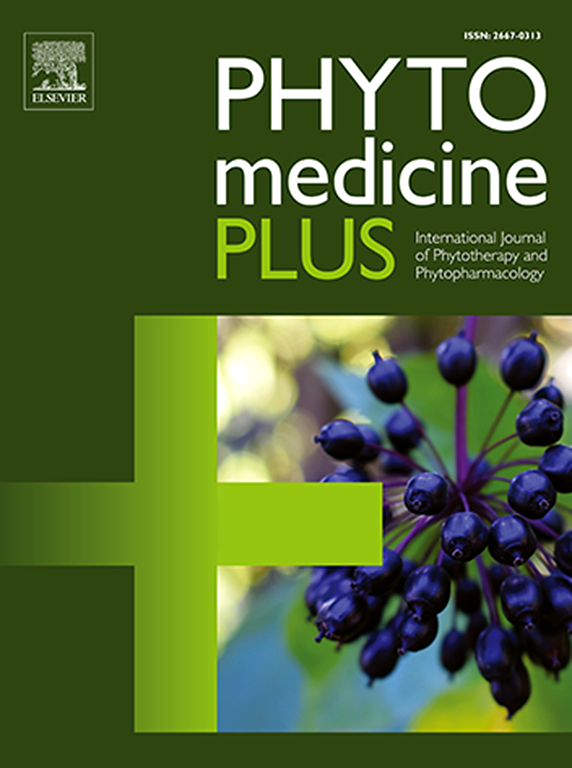Quantitative proteomics and targeted metabolomics reveal the role of Cassia siamea L. extract in the response to high-fat diet-induced obesity in Drosophila
Q3 Pharmacology, Toxicology and Pharmaceutics
引用次数: 0
Abstract
Background
Cassia siamea L., an angiosperm native to Southeast Asia, has been traditionally used for various medicinal purposes, including antifever, antihypertensive, and antidiabetic applications. Despite its traditional use, limited scientific evidence supports its antiobesity properties.
Purpose
This study aimed to investigate the antiobesity effects of C. siamea extract (CSE) both in vitro and in vivo.
Methods
CSE was obtained via extraction from C. siamea wood with 70 % ethanol and its phytochemical content was analyzed by gas chromatography–mass spectrometry (GC‒MS) and high-performance liquid chromatography (HPLC). Drosophila was used to examine the effects of supplementation with C. siamea extract on lipase activity, body weight, triglyceride levels, physical strength, survival, and antioxidant activity in Drosophila fed a high-fat diet. Moreover, this study investigated the effects of the extract combined with a high-fat diet on amino acid metabolism and proteomic profiles to clarify its mechanism of action.
Results
Syringic acid was the most abundant phenolic compound in CSE, followed by gallic acid, sinapic acid, protocatechuic acid, cinnamic acid, chlorogenic acid, and ferulic acid. In vitro, CSE significantly inhibited pancreatic lipase activity (IC50 = 67.73±3.24 µg/mL) in a noncompetitive manner. In a high-fat diet-fed Drosophila model, CSE supplementation (10 mg/mL) reduced lipase activity and triglyceride levels and improved body weight, suggesting antiobesity and potential antidiabetic effects. Additionally, CSE increased survival rates, physical strength, and antioxidant capacity, as evidenced by increased SOD1 activity and resistance to oxidative stress. CSE helped restore disrupted amino acid levels, particularly glutamine, alanine, and proline, indicating improved metabolic regulation. The results of the quantitative proteomics analysis indicate that a high-fat diet (HFD) alters proteins within metabolic pathways, which can be minimized in severity through CSE therapy.
Conclusion
These findings highlight the potential therapeutic role of CSE in managing obesity and related metabolic disorders.

定量蛋白质组学和靶向代谢组学揭示了决明子提取物在果蝇高脂肪饮食诱导的肥胖反应中的作用
桂花(cassia siamea L.)是一种原产于东南亚的被子植物,传统上被用于多种药用目的,包括退热、降压和降糖。尽管它的传统用途,有限的科学证据支持其抗肥胖特性。目的通过体外和体内实验,探讨三叶草提取物的抗肥胖作用。方法采用70%乙醇提取三叶草中scse,采用气相色谱-质谱联用(GC-MS)和高效液相色谱(HPLC)分析其植物化学成分。研究人员以果蝇为研究对象,研究了在喂食高脂肪食物的果蝇中,补充蚕豆提取物对脂肪酶活性、体重、甘油三酯水平、体力、存活率和抗氧化活性的影响。此外,本研究还研究了高脂日粮联合提取物对氨基酸代谢和蛋白质组学的影响,以阐明其作用机制。结果丁香酸含量最高,其次为没食子酸、辛酸、原儿茶酸、肉桂酸、绿原酸和阿魏酸。在体外,CSE以非竞争性方式显著抑制胰脂肪酶活性(IC50 = 67.73±3.24µg/mL)。在高脂肪饮食喂养的果蝇模型中,补充CSE (10 mg/mL)可降低脂肪酶活性和甘油三酯水平,改善体重,提示抗肥胖和潜在的抗糖尿病作用。此外,CSE提高了存活率、体力和抗氧化能力,SOD1活性增加,抗氧化能力增强。CSE有助于恢复被破坏的氨基酸水平,特别是谷氨酰胺、丙氨酸和脯氨酸,表明代谢调节得到改善。定量蛋白质组学分析的结果表明,高脂肪饮食(HFD)改变了代谢途径中的蛋白质,通过CSE治疗可以将其严重程度降至最低。结论CSE在肥胖及相关代谢紊乱的治疗中具有潜在的治疗作用。
本文章由计算机程序翻译,如有差异,请以英文原文为准。
求助全文
约1分钟内获得全文
求助全文
来源期刊

Phytomedicine Plus
Medicine-Complementary and Alternative Medicine
CiteScore
3.70
自引率
0.00%
发文量
178
审稿时长
81 days
期刊介绍:
 求助内容:
求助内容: 应助结果提醒方式:
应助结果提醒方式:


